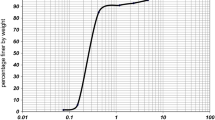Summary
During their metabolism, microorganisms can produce acids able to bring about the degradation of cement. Two acid-producing alkalophilic fungal strains have been isolated from soil, a strain ofAspergillus niger which produces gluconic and oxalic acid and ofMycelia sterila which produces gluconic and malic acid. After eleven months of contact the acids produced byAspergillus dissolved portlandite with a low leaching of calcium, increased the cement porosity by 11.4%, and reduced the bending strength by 78%. The second strain is responsible for a significant dissolution of portlandite with a leaching of calcium of 4.2% of the initial content, an increase of the porosity of 11%, and a loss of the bending strength of 62%. Direct contact of mycelia with the cement surface is not necessary for effective dissolution to take place. Low pH and a high temperature favor the the production of acids.
Similar content being viewed by others
References
Berthelin, J., Etude expérimentale des méchanisms d'altération des minéraux par des microorganismes hétérotrophes. Thesis Doct. Nancy (France) 1976.
Berthelin, J., Microbial weathering process, in: Microbial Geochemistry, pp. 223–262. Ed. W. E. Krumbein. Blackwell Scientific Publications, Oxford 1983.
Berthelin, J., and Dommergues, Y., Rôle des produits de métabolisme microbien dans la solubilisation des minéraux d'une arène granitique. Rev. Ecol. Biol. Sol9 (1972) 397–406.
Cheynier, V., Feinberg, M., Charas, C., and Ducauze, C., Application of response surface methodology to evaluation of bioconversion experimental conditions. Appl. envir. Microbiol.45 (1983) 634–63.
Dommergues, Y., and Mangenot, F., Ecologie Microbienne du Sol. Masson et Cie., Paris 1970.
Dubois, J., Le béton face aux agressions chimiques. Chant. Mag.80 (1977) 85–89.
Dreux, G., Nouveau Guide du Béton, 5th Edn. Collection UTIITBTP. Eyrolles, Paris 1986.
Fannin, T. E., Marcus, M. O., Anderson, D. A., and Bergman, H. L., Use of a fractional factorial design to evaluate interactions of environmental factors affecting biodegradation rates. Appl. envir. Microbiol.42 (1981) 936–943.
Fassatovia, O., Moulds and filamentous fungi in technical microbiology. Progress in Industrial Microbiology 22. Elsevier, Amsterdam 1986.
Guerrant, G. O., Lambert, M. A., and Wayne Moss, C., Analysis of short-chain acids from anaerobic bacteria by high-performance liquid chromatography. J. clin. Microbiol.16 (1982) 355–360.
Jaton, C., Attaque des pierres calcaires et des bétons, in: Dégradation Microbienne des Matériaux. Coll. colloq. sém.28 (1974) 41–56. Technip, Paris.
Krumbein, W. E., Rôle des microorganismes dans la génèse, la diagénèse et la dégradation des roches en place. Rev. Ecol. Biol. Sol9 (1972) 283–319.
Lea, F. M., The Chemistry of Cement and Concrete, 3rd Edn. Arnold, London 1970.
Milde, K., Sand, W., and Bock, E.,Thiobacilli of the corroded concrete walls of the Hamburg sewer system. J. gen. Microbiol.123 (1983) 1327–1333.
Parker, C. D., The corrosion of concrete. 1: Isolation of a species of bacterium associated with the corrosion of concrete exposed to atmosphere containing hydrogen sulphide. Aust. J. exp. Biol. med. Sci.23 (1945) 81–90.
Parker, C. D., The corrosion of concrete. 2: The function ofThiobacillus concretivorus (nov spec) in the corrosion of concrete exposed to atmosphere containing hydrogen sulphide. Aust. J. exp. Biol. med Sci.23 (1945) 91–98.
Perfettini, J., Etude de l'altération d'un matériau d'enrobage des déchets radioactifs, le ciment CPA, par des microorganismes hétérotrophes isolés de milieux naturels. Thesis Doct. Marseille (France) 1989.
Revertegat, E., and Bernaudat, F., Rôle de la porosité dans la durabilité des liants hydrauliques. 8th International Congress of Cement Chemistry, Thème 4, vol. 5. September 1986, Rio de Janeiro.
Revertegat, E., and Gegout, P., Influence of porosity on durability of cement pastes. 2nd CANMET/ACI International Conference on Durability of Concrete. 4–9 August 1990. Montreal (in press).
Strzelczyk, A. B., Microbial deterioration: stones, in: Economic Microbiology, vol. 6. Academic Press, New York 1981.
West, J. M., MacKinley, I. G., and Chapman, N. A., Microbes in deep geological systems and their possible influence on radioactive waste disposal. Radioact. Waste Manag. nucl. Fuel Cycle3 (1982) 1–15.
Author information
Authors and Affiliations
Rights and permissions
About this article
Cite this article
Perfettini, J.V., Revertegat, E. & Langomazino, N. Evaluation of cement degradation induced by the metabolic products of two fungal strains. Experientia 47, 527–533 (1991). https://doi.org/10.1007/BF01949872
Published:
Issue Date:
DOI: https://doi.org/10.1007/BF01949872




